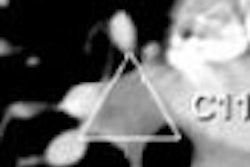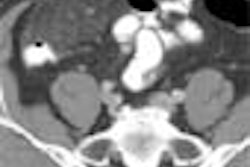Researchers in Florida have developed a triphasic multidetector-row CT (MDCT) method for ruling out the three most dangerous causes of chest pain. Their 64-slice CT protocol examines the coronary arteries, pulmonary arteries, and the aortic arch in a single pass, generating even contrast enhancement in all three regions.
The protocol can "rule out the three major causes of complications: coronary artery disease, pulmonary embolism and aortic dissection," said Dr. Norbert Wilke, a radiologist at the University of Florida, Jacksonville. "CT has been very effective, with high sensitivity and specificity in ruling out pulmonary embolism (PE) and aortic dissection. Our hypothesis was to develop a method (that) could reliably and robustly image the coronary arteries, the pulmonary arteries and the aorta."
Wilke discussed the results of his team's small study at the 2006 RSNA meeting in Chicago. His co-investigators were Dr. Minh Nguyen, Dr. Kiran Kareti, Christopher Klassen, and Dr. Ivan Avala.
The group scanned 11 patients (average age 50, average BMI 30.6, heart rate 50-60 bpm at scan) craniocaudally from the lung apices to the diaphragm using a Sensation 64-slice scanner (Siemens Medical Solutions, Malvern, PA).
The ECG-gated thoracic exam -- "basically a lung protocol," Wilke said, used 64 x 0.6-mm collimation, rotation time of 0.33 seconds, pitch 0.3, 120 kVp and 500-600 mAs depending on body habitus. The scan took 12-17 seconds, he said.
The bolus trigger's region of interest was set at the left atrium, with a threshold of 120 HU and a five-second delay to allow for table repositioning and patient breath-hold, according to Wilke.
"Most patients had been selected from the emergency department on the basis of acute chest pain and intermediate risk score for major coronary events," he said.
Iodinated contrast (Ultravist 370, Berlex Imaging, Wayne, NJ) was injected using a dual-syringe injector (Stellant D, Medrad, Indianola, PA) with an 18-gauge needle or larger in the antecubital vein. The biphasic injection consisted of 80 cc of contrast, followed by a 50 cc mixture (1:1) of contrast and saline, followed by 50 cc of saline alone, all injected at 5 cc/sec.
Contrast enhancement was substantially even across all three areas of interest, Wilke said. Anova analysis of the 11 studies showed no significant difference (p = 0.014) in the average Hounsfield unit value of the main pulmonary artery (380 HU), left pulmonary artery (382 HU), right pulmonary artery (381 HU), distal pulmonary arteries (354 HU), proximal left main artery (410 HU), and the proximal right coronary artery (382 HU).
A Wilcoxon unpaired test showed a significant difference (p = 0.03) in average Hounsfield unit value of the distal pulmonary arteries among the 11 studies using the new protocol (354 HU) compared to three studies using a traditional coronary CT angiography (CTA) protocol (HU 209).
There was no significant difference in the average Hounsfield unit value of the proximal left main artery (412 HU) and proximal right coronary artery (398 HU) among the 11 studies using the triple-rule-out protocol compared to three studies with a traditional coronary CTA protocol (416 HU), (411 HU), the team wrote in an accompanying abstract.
"With a dedicated biphasic injection protocol (80 cc contrast followed by 40 cc) you cannot afford to fill the right side of the heart -- it's basically washed out," Wilke said of the facility's traditional protocol. "With the triphasic protocol, you extend the injection; you see the curve of the right atrium, the filling of the right ventricle. We appreciate that we have at least a medium density increase in the right ventricle versus the dedicated protocol."
As for limitations, "if the heart rate is too fast, we don't get enough data for multisegmental reconstruction," he said.
The triple-rule-out method allows for cost-effective, rapid assessment of PE, coronary stenosis, and thoracic aortic dissection in ER patients with a single acquisition, he said.
The radiation dose is substantially lower than for three dedicated exams. The group calculated the average dose length product at 1,049, compared to about 400 for a dedicated PE exam, and about 1,004 for coronary CTA.
"The protocol is recommended in patients with acute chest pain, preferably emergency room patients who have been identified at intermediate risk for coronary artery disease, and also having the need to exclude PE and aortic dissection," Wilke said. "In this method, there is no compromise in Hounsfield units or enhancement patterns for all vascular territories. And the radiation dose is acceptable."
By Eric Barnes
AuntMinnie.com staff writer
January 22, 2007
Related Reading
Advanced visualization alone reduces coronary CTA accuracy, December 22, 2006
Calcium scoring, CTA combine for better diagnosis of coronary artery disease, December 26, 2006
Cardiac CT yields significant extracardiac findings, November 26, 2006
Cardiac CT evolves on multiple fronts, November 20, 2006
Dual-source imaging promises better CT scanning, June 15, 2006
Copyright © 2007 AuntMinnie.com



















